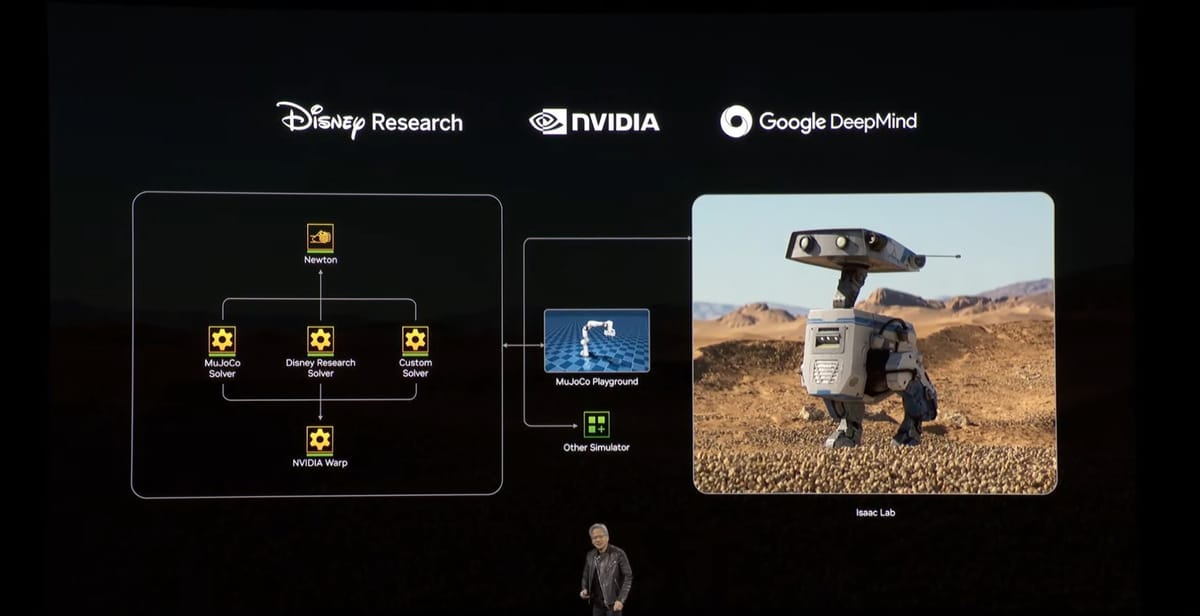
NVIDIA, Google DeepMind, and Disney Research have announced Newton, an open-source physics engine aimed at bridging the gap between simulation and real-world robotics. Built on NVIDIA’s Warp framework, Newton will provide robotics developers with a high-performance, customizable, and scalable simulation environment optimized for AI-driven humanoid robots and robotic characters.
Key Points:
- Newton is an open-source physics engine designed for advanced robotic simulations.
- It is built on NVIDIA Warp and will be compatible with MuJoCo and NVIDIA Isaac Lab.
- MuJoCo-Warp, a collaboration with Google DeepMind, accelerates robotics workloads by over 70x.
- Disney will use Newton for its next-generation robotic characters, including the expressive BDX droids.
Announced at GTC 2025, Newton aims to enhance robot learning, support differentiable physics, and accelerate AI-driven humanoid robots. It is built on NVIDIA Warp, a CUDA-based acceleration library that enables GPU-powered physics simulations. It is optimized for robot learning frameworks, including MuJoCo Playground and NVIDIA Isaac Lab, making it an essential tool for developers working on generalist humanoid robots.
A key part of this initiative is MuJoCo-Warp, a DeepMind-developed extension of MuJoCo that speeds up robotics machine learning workloads. According to NVIDIA, MuJoCo-Warp provides a 70x acceleration for humanoid simulations and a 100x speedup for in-hand manipulation tasks. This level of efficiency could significantly reduce the training time required for robotic systems.
Disney’s Role in Newton and Next-Gen Robotics
Disney Research will be one of the first adopters of Newton, integrating it into their robotic character platform to develop expressive, interactive robots for theme parks and entertainment. To close out GTC 2025, NVIDIA CEO Jensen Huang brought on Disney’s BDX droids, a Star Wars-inspired robots that use Newton’s physics simulations to create lifelike movements and gestures.
Kyle Laughlin, Senior Vice President at Walt Disney Imagineering R&D, emphasized that Newton will play a pivotal role in bringing robotic characters to life:
“The BDX droids are just the beginning. We’re committed to bringing more characters to life in ways the world hasn’t seen before, and this collaboration with Disney Research, NVIDIA, and Google DeepMind is a key part of that vision.”
Beyond entertainment, Newton’s capabilities extend to industrial robotics, AI-driven humanoid assistants, and next-generation manufacturing systems, all of which require high-fidelity simulations before real-world deployment.
Bridging the Sim-to-Real Gap
One of the biggest challenges in robotics development is the sim-to-real gap—the difference between how robots behave in simulations versus the real world. Newton tackles this problem with differentiable physics, allowing robots to learn from physics-based simulations and adjust their movements for real-world conditions.
Newton is also designed to be extensible, meaning developers can add custom solvers, integrate multiphysics environments, and simulate interactions with deformable objects like food, cloth, or sand. This flexibility makes Newton a powerful tool for training robots across diverse scenarios.
Availability and Future Development
Newton is expected to be available later this year, with NVIDIA, Google DeepMind, and Disney Research continuing to refine its capabilities. The engine will be open-source, allowing researchers and developers to contribute and extend its functionality.
As robotics moves toward generalist AI-powered systems, tools like Newton will be critical in helping robots operate safely, efficiently, and intelligently in human environments. With its combination of high-performance physics modeling, AI integration, and real-world adaptability, Newton could be a game-changer for humanoid robots and robotic characters alike.

